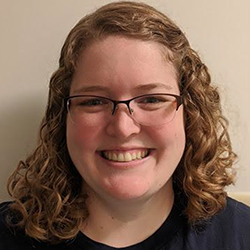Erin Scanlon
Permanent Teaching Professor and Physics Education Researcher
Why Physics?
A love for physics
Erin was mesmerized by physics in high school when given a classroom challenge, to place a bottle on the ground at the exact point where it would catch a weight dropped from a pendulum. “I worked through the calculations, placed the bottle, and the weight landed perfectly in the bottle ON THE FIRST TRY! I was able to predict the future! It was so exciting.” She decided to earn a physics degree, persisting through the undergraduate work despite being one of the few women in the physics class.
A love for teaching physics
Erin pursued atomic, molecular, and optical (AMO) physics for her graduate degree but found she did not enjoy the program. She had become enamored of physics teaching during her undergraduate teaching assistant experience, but as a graduate student she was not given the same opportunities to contribute to student learning. She left that graduate program and became an adjunct professor, where she fell in love with teaching again. “I loved working with students, designing courses, and supporting students to reach their educational goals,” she says.
Pursuing physics education research (PER)
Erin decided to return to school to study education. “I wanted to better support students in the courses I taught,” she explained. Her graduate degree was in Curriculum and Instruction, within a School of Education. After graduate school she did postdoctoral work in physics education research. She enjoyed blending research and teaching and continues to do so in her current job.
A fulfilling job which blends teaching, research and service
“Currently, I am a teaching focused faculty member and I LOVE it,” says Erin. “I feel like every day I get to live out my life goals and I have the opportunity to work on projects that I am passionate about. I am happy.”
Using Physics and PER
Problem solving and critical thinking skills
Erin uses the problem-solving and critical thinking skills she developed during her degrees, using her ability to analyze a problem to work to a good solution in teaching, research, and her personal life.
Communication skills
Erin also finds that the communication skills she learned during her degrees helped her to talk about science to a broad audience, such as students, colleagues outside of her field, or the general public. She developed these skills as a student by engaging in outreach activities, and taking two science communication courses.
Applying research to teaching
Erin continues to conduct physics education research (PER), even though it is not a formal part of her job duties. Her research is driven by things she notices aren’t working in her own class. “Everything I do in PER makes me a better instructor and a better person,” she says. The listening skills she developed conducting research, including student interviews, makes her more tuned in to what her students are experiencing. She also uses the findings and tools of PER in her teaching.
Advice for Students
Get teaching experience
If you want to be a teaching professor, Erin suggests getting any teaching experience you can, such as working in outreach, or serving as a teaching assistant. “My teaching experience got me this position and made me successful.”
Gain expertise in physics education research
If possible, conduct physics education research, even if it’s a short project or working on course design. Ask your advisor to send you to conferences in physics teaching (such as the American Association of Physics Teachers; AAPT, or Physics Education Research Conference; PERC).
You can transition from physics to PER
“I wish more undergraduates knew about PER,” says Erin. But be ready to feel a little disoriented at first. “I felt like a fish out of water,” she says of her own transition. The references, the vocabulary, and the world view were all different. “Embrace the discomfort because once you’re through, you’ll have common ground and vocabulary to communicate with people outside physics.” She also notes that in education, it was a pleasant change to not be the only woman in the room.
Consider a PhD in Education
Erin did her doctorate in a School of Education and suggests that potential PER students keep their options open. “Pick the advisor and the research, rather than focusing on whether the program is in education or physics.” Erin feels she gained a broader base of knowledge by spending time learning the ideologies and methods of education.
Find what works for you
“There is not a single path to become a physics professor,” says Erin. She combines her skills from a PhD in education with technical knowledge in physics through a path that met her goals. “There is no one right answer, you have to figure out what makes sense for you.”
About Erin

Credit: Erin Scanlon
Interesting Highlights
- Has a position as a physics professor without holding a PhD in physics
- Combines teaching and research
- Loves antiquing, hanging out at the beach, and listening to the waves
Advice for Students
- Get teaching experience
- Get expertise in physics education research (PER)
- You can transition from physics to PER
- Consider a PhD in Education
- Find what works for you
